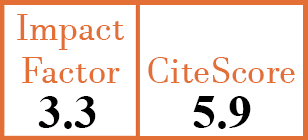Full Papers
Peripheral blood circular RNA hsa_circ_0082688-hsa_circ_0008675 can be used as a candidate biomarker of systemic lupus erythematosus with renal involvement
Q. Luo1, L. Zhang2, L. Xiong3, B. Fu4, Y. Guo5, Z. Huang6, J. Li7
- Department of Clinical Laboratory, The First Affiliated Hospital of Nanchang University, Nanchang, Jiangxi, China.
- Department of Clinical Laboratory, The First Affiliated Hospital of Nanchang University, Nanchang, Jiangxi, China.
- Department of Clinical Laboratory, Jiangxi Province Blood Center, Nanchang, Jiangxi, China.
- Department of Rheumatology, the First Affiliated Hospital of Nanchang University, Nanchang, Jiangxi, China.
- Department of Clinical Laboratory, The First Affiliated Hospital of Nanchang University, Nanchang, Jiangxi, China.
- Department of Clinical Laboratory, The First Affiliated Hospital of Nanchang University, Nanchang, Jiangxi, China.
- Department of Clinical Laboratory, The First Affiliated Hospital of Nanchang University, Nanchang, Jiangxi, China. lisir361@163.com
CER12490
2020 Vol.38, N°5
PI 0822, PF 0833
Full Papers
Free to view
(click on article PDF icon to read the article)
PMID: 32940208 [PubMed]
Received: 10/06/2019
Accepted : 02/09/2019
In Press: 16/09/2020
Published: 02/10/2020
Abstract
OBJECTIVES:
This research aimed to investigate the level of peripheral blood circular RNAs (circRNAs) from systemic lupus erythematosus (SLE) patients with renal involvement (SLE+RI) to identify novel biomarkers for SLE+RI screening.
METHODS:
circRNAs expression in peripheral blood from 3 SLE+RI patients, 3 SLE patients without renal involvement (SLE-RI) and 3 healthy controls (HC) were performed by microarray. All upregulated expressed circRNAs coming from “circBase” between the three groups were determined by real time-quantitative polymerase chain reaction (qRT-PCR) in SLE+RI, SLE-RI, HC, neprhritis without SLE (NWS) and rheumatoid arthritis (RA) patients. The diagnostic value of these circRNAs for SLE+RI was evaluated by receiver operating characteristic (ROC) curve. A 15-day follow-up was evaluated in 7 newly diagnosed SLE+RI patients to investigate the level change of these circRNAs after treatment.
RESULTS:
We confirmed that the level of hsa_circ_0082688, hsa_circ_0082689 and hsa_circ_0008675 were significantly elevated in SLE+RI patients with respect to the SLE-RI, RA, NWS patients and the HC. The level of hsa_circ_0082688, hsa_circ_0082689 and hsa_circ_0008675 were associated with C4, anti-dsDNA, anti-nucleosome. The level of hsa_circ_0008675 was associated with C3, and the level of hsa_circ_0082688 and hsa_circ_0008675 were associated with treatment. ROC curve analysis suggested that hsa_circ_0082688-hsa_circ_0008675 had significant value in the diagnosis of new-onset SLE+RI patients than the controls (new-onset SLE-RI patients, RA patients, NWS patients and HC) with an area under the curve of 0.925, sensitivity of 79.17% and specificity of 96.64%.
CONCLUSIONS:
This study suggests that peripheral blood hsa_circ_0082688-hsa_circ_0008675 level in SLE+RI patients is upregulated and may also serve as a potential biomarker for SLE+RI patient diagnosis and treatment.


